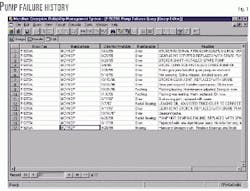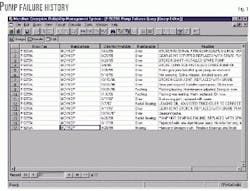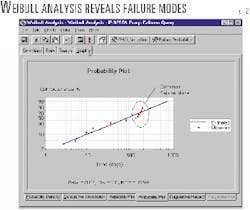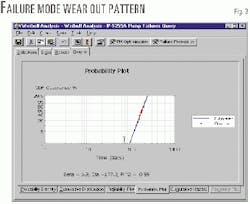A Weibull reliability analysis of a repeated pump problem at Chevron Corp.'s Pascagoula, Miss., refinery helped the company identify the failure mode and improve reliability.
Rather than accepting the frequent repairs as normal for rotary pumps, maintenance personnel used the analysis to understand that the pump failures were not random.
With the understanding that the pump design may not be appropriate for the application, Chevron can select a more robust design to extend the service life of the equipment.
Repair history
Before personnel implemented the Weibull analysis, this particular rotary pump required constant repair. The plant's database documents its repair history (Fig. 1). The data showed that the failures were associated with breakage of internal parts. The build up of product inside the pump caused the breakages.
In the past 5 years, the pump had experienced 17 failures, excessive for a rotary pump.
Monty Reyer, computer planner for the refinery's reliability group, agreed that the failure frequency was unusual.
He said, "Based on industry averages for this type of equipment, we should only have experienced one or two failures in the 5-year period. In fact, we've experienced a total of 17 failures. This means we have unnecessarily repaired the pump 15 times over the 5-year period."
Analysis
Chevron used an enterprise-reliability management software by Meridium Inc., a company based in Roanoke, Va., to access reliability data and perform a Weibull analysis.
While the refiner thought the problem was random, the analysis showed that it was chronic. This information helped Chevron realize that it needed to evaluate the design and application of the pump.
Weibull is a statistical analysis tool that helps identify failure patterns. Since the failure pattern for pumps is often closely related with the appropriate corrective action, the analysis helps identify the proper solution as well as the problem.
The reliability analysis revealed that there were two modes of failure associated with this pump (Fig. 2).
The first mode, represented by randomly spaced data points, most likely represents repairs that were not effective in addressing the cause of failures. The second mode of failure is the random failures that occurred when the pump operated for fewer than 60 days.
The right side of Fig. 2 shows a tight cluster of failures that represents a design weakness in the pump. Examination of the causes of failure from the work description data in Fig. 1 suggests some internal breakage of rotating elements.
In both cases, the repair required the installation of a rebuilt pump. Thus, even if the repairs were conducted correctly, Chevron could only expect the pump to run for 5 months before the next failure occurrence.
Fig. 3 characterizes the "wear out" pattern associated with the identified failure mode. This pattern says that there is a distinctive, expected life with very little chance that the pump will survive beyond this time (this value is given by the mean time between failure). The cumulative distribution function (CDF) gives the probability of failure after a given running time.
Reyer estimates that the company could have saved $24,000 during the 5-year period on this pump alone had it used the software to analyze the problem from the beginning. "We have another 14 installations of this type of pump in the plant," he said, "and I'm told that at least 6 of them have a history of excessive repairs."



